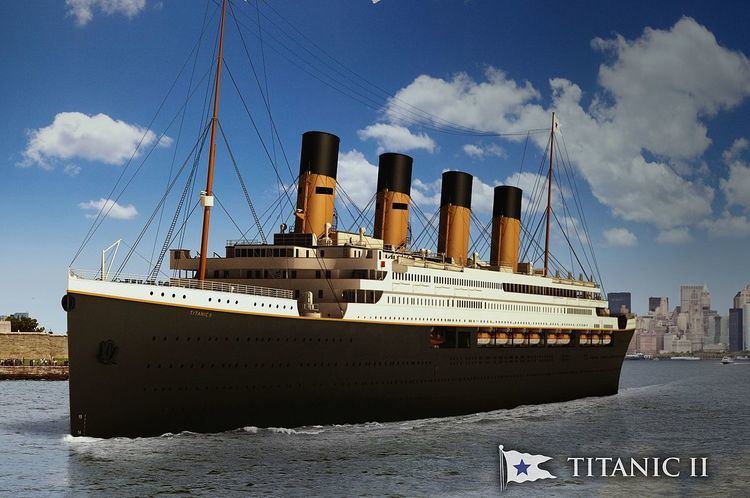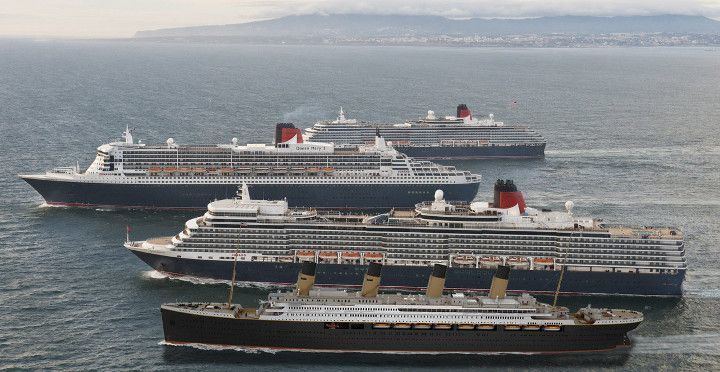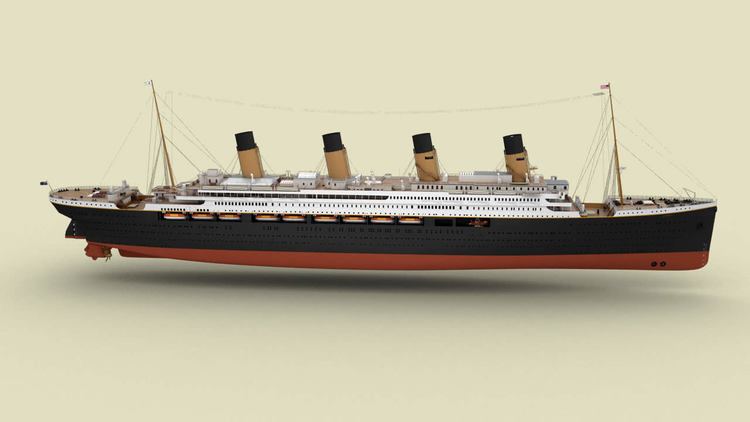Name Titanic II Tonnage 56,000 GT (estimate) Beam 32 m | Status Unknown Length 269 m | |
 | ||
Cost $500 million (estimated) Class and type Modern interpretation of Olympic-class ocean liner | ||
Titanic II is a planned ocean liner, to be built as a modern-day replica of the Olympic-class RMS Titanic. The new ship will have a gross tonnage (GT) of 56,000 while the original ship measured about 46,000 gross register tons (GRT). The project was announced by Australian millionaire Clive Palmer in April 2012, as the flagship of a proposed cruise company Blue Star Line Pty. Ltd. of Brisbane, Australia. The intended launch date was originally set in 2016, with the ship sailing from Southampton to New York within the same year. However, construction of the ship has been delayed to 2018. As of February 2017 construction has not begun on the vessel.
Contents
- Previous projects
- Design stage
- Design and construction
- Comparison with the original RMS Titanic
- Power plant and propulsion
- Interior
- Criticism
- Alleged project collapse
- Unrelated project
- References

Previous projects

The concept of a functioning replica of the Titanic has been explored several times, especially following the resurgence of interest following the release of James Cameron's film in 1997. The most widely publicized project was that of South African businessman Sarel Gous in 1998. The South African project began in 1998, and was one of the subjects of an article in Popular Mechanics magazine in September of that year. The article discussed the changes to the original design required to produce a safe and economically viable ship, including a welded rather than riveted hull, diesel-electric propulsion in place of steam engines, and a bulbous bow. The article concluded that although the various Titanic revival projects would cost $400–$600 million, they could be economically viable.

Although he originally intended to construct the ship in Durban, Gous presented his £500 million proposal to Belfast City Council in June 2000. He commissioned Olsen Designs to design the ship, advised by Harland and Wolff Technical Services who produced a feasibility study, and Callcott Anderson to design the interior. In November 2000, he began his attempts to raise capital, including through government grants and a stock market flotation. After signing an agreement with a Monaco-based investment banking company, Gous claimed that construction would begin at Harland and Wolff within nine months. The design changed repeatedly, with claims emerging of 'the world's largest liner' with capacity for 2,600 passengers, and increasingly divergent plans for a heliport, swimming pools and discos eventually being released. In 2006, after repeatedly failing to secure investment, the project was abandoned.
Design stage
Clive Palmer first announced the project in a press conference on 30 April 2012, following the signature of a memorandum of understanding with state-owned Chinese shipyard CSC Jinling ten days before. On 19 June, it was announced that Finnish naval architecture firm Deltamarin Ltd. had been commissioned to undertake the design of the ship, and on 17 July a preliminary general arrangement was published.

In October 2012, Blue Star Line announced that Titanic expert Steve Hall had been appointed as Design Consultant and Historian for the project, and that Titanic interiors expert Daniel Klistorner had been appointed as Interior Design Consultant and Historian. Hall and Klistorner had previously co-authored books such as Titanic: The Ship Magnificent and Titanic in Photographs, and gave a technical presentation at the unveiling of the designs in New York, as well as at the dinner in London. Later that month, it was announced that an advisory board would be formed to provide "suggestions and recommendations to Blue Star Line to ensure the Titanic II appropriately and respectfully pays homage to Titanic, her crew and passengers." Terry Ismay, the great-great nephew of White Star Line chairman and Titanic survivor J. Bruce Ismay, will be a member of the board, as well as Helen Benziger, great-granddaughter of Titanic survivor Margaret "Molly" Brown.
The design for the Titanic II was unveiled at worldwide launch events in Macau (China), New York (United States), Halifax (Canada), London & Southampton (United Kingdom). The gala event in New York was the official Global Launch and was held aboard the USS Intrepid in New York City on 26 February 2013. The gala dinner in London (UK) was held at the Natural History Museum on 2 March, and was accompanied by a display of items salvaged from the Titanic. There was also a breakfast held in Southampton on 13 March.
On 16 April 2013 it was announced that Deltamarin had been contracted for the project development phase, and would be responsible for coordinating the various parties involved in the project, including the shipyard, architects, interior designers and operations managers. The feasibility study was complete, and the project development phase was ongoing. The signature of a contract and keel laying was expected in March 2014.
Further contracts and agreements relating to the design and construction were announced later in 2013; the appointment of V.Ships Leisure as ship management services partner, and of Tillberg Design as provider of architectural and interior design services. On 17 July 2013, Blue Star Line announced that the classification society Lloyd's Register has joined the Titanic II project. The work carried by Lloyd's would ensure that the ship's design complied with the current SOLAS regulations.
Model testing using a 9.3-metre (31 ft) wooden model was undertaken in September 2013 at the Hamburgische Schiffbau-Versuchsanstalt (HSVA). Resistance and powering tests were carried out in a 300-metre (980 ft) towing tank.
In an interview in February 2014, Palmer claimed that keel laying would take place in September 2014. He cautioned that the project was "a big job", that the original Titanic took seven years to build while they have been working for only two and a half, and said that he would have liked to start sooner but "wanted to make sure we don't make any mistakes". He claimed that a selection of cabins were being constructed on land for approval, and that this would be completed by July 2014.
In April 2016 the administrators for Palmer's closed nickel refining company, Queensland Nickel alleged that almost $A6 million had been taken from that company to pay for the development and marketing of the Titanic II. At that time the administrators indicated that they would seek to recover this money.
Design and construction
The gross tonnage of the replica will be 56,000 GT, considerably more than that of the original.
Comparison with the original RMS Titanic
The ship is designed to be as similar in internal and external appearance to the Titanic as possible. However, today's safety regulations and economic considerations dictated several major changes to the design, including:
Power plant and propulsion
For economic reasons, the steam engines and coal-fired boilers of the original Titanic were replaced with a modern diesel-electric propulsion system. The space which housed the boilers would have been used for crew quarters and ships systems. Power was to be produced by four Wärtsilä 46F medium-speed four-stroke diesel generating sets; two twelve-cylinder 12V46F engines producing 14,400 kilowatts (19,300 hp) each, and two eight-cylinder 8L46F engines producing 9,600 kilowatts (12,900 hp) each, running on heavy fuel oil and marine gas oil. Propulsion would have been by three azimuth thrusters which would also be used for maneuvering, while the replica of the rudder of the Titanic II is purely cosmetic, and would not have extended substantially below the waterline. The positioning of the azimuth thrusters necessitated the stern being made substantially more blunt than the original.
Interior
The interior of the ship was intended to be as similar as possible to the original. Tillberg Design of Sweden was contracted to produce drawings replicating Titanic's original interiors. However, the original wooden panelling does not conform to modern fire regulations, so as in Queen Mary 2, veneers would have had to be used. Plans showed a layout broadly similar to the original, but with the third-class cabins modernised, and consideration being given to en-suite cabins throughout the ship. The room freed up by eliminating the steam boilers of the original ship would have been used for crew quarters and various services.
Criticism
The Titanic II represents the first major passenger vessel constructed in China, a country with much more experience of building cargo ships than cruise ships, and a significant investment would have been required to ensure it met the much more stringent safety requirements for passenger vessels.
The Chinese state-owned CSC Jinling shipyard has never built a large passenger vessel. In addition, it has no drydock, instead using side launching from a 200 m slipway. The 269 m Titanic II would have been the largest side-launched vessel in history by a huge margin, and would have required a significant extension to the shipyard's facilities.
Representatives from the shipyard questioned whether the ship could be completed by 2016, and emphasized that no contract had been signed.
Clive Palmer has been described as an "eccentric billionaire" with a reputation for bizarre publicity stunts, such as the attempt to create a massive Jurassic Park style dinosaur theme park at his golf resort. It has also been noted that the publicity surrounding the Titanic II coincided with Palmer's announcement of his entry into Australian federal politics, which was made immediately following the Titanic II conference. Palmer had previously claimed that he was the target of a conspiracy involving Barack Obama, the CIA, the Rockefeller Foundation and Greenpeace, who he believed were attempting to close down his mining operation. In 2010, Palmer started a company called Zeppelin International, with the intention of making a commercially viable Zeppelin. After the plan came to nothing, it was ridiculed as the 'bizarre move of the year' by Australian business website Smartcompany. He has gained a reputation in Australia for floating ambitious and unusual business ideas which he fails to see through, and the Titanic II has been described as "a classic Clive Palmer announcement."
The idea of a commercialised replica of the Titanic has itself been criticised, being described as "insensitive" and "a mockery of the memory of those who died". Cunard Line, which merged with the White Star Line, stated that they "have always been very mindful and very respectful of such a tragic event [and] don't think that building a replica or a 'II' is appropriate."
Palmer's alleged use of funds drawn from Queensland Nickel for the Titanic II project was criticised by the administrators appointed for that company after it closed. In their April 2016 report, the administrators stated that payments from Queensland Nickel to Blue Star Line had been "uncommercial and director-related transactions". Palmer has rejected the claims made against him in the report, including those related to the Titanic II.
Alleged project collapse
When the project was first announced in 2012, Palmer claimed that construction would begin before the end of the year, with a 2016 launch. The following year reports emerged that Clive Palmer was experiencing financial difficulties. The start of construction was postponed to March 2014, then to late 2014. When construction had still not begun in 2015 a spokesman for Palmer said the project had merely been delayed, and that the new ship would be launched in 2018 - two years later than initially planned. However Deltamarin had told an Australian Broadcasting Corporation journalist that work on the Titanic II project had been halted while workers at the Chinese shipyard identified as the likely site of construction were highly skeptical that the project would ever move beyond the proposal stage and the Blue Star Line trademark was "abandoned." Queensland Nickel went bankrupt and Palmer faced freezing of personal assets to recoup money owed the company's employees and creditors. He did not stand for re-election to his House of Representatives seat but stated that he might resume work on the project in his retirement.
However, in 2014, Clive Palmer's privately owned Blue Star Line and AVIC Kaixin (Beijing) Ship Industry Co Ltd. signed a memorandum of understanding (which commonly precedes a contract) which states that AVIC will "represent Blue Star Line in the promotion of the Titanic II project and coordination of Titanic II sponsors from mainland China."
Unrelated project
Clive Palmer's project should not be confused with a Chinese Titanic replica ship which had its keel laying on November 29, 2016. Commissioned by Seven Star Energy Investment, it is to function as a theme park attraction and a stationary floating hotel on the River Qi in Sichuan. Unlike Palmer's Titanic II, the all-Chinese replica is not intended to sail on any ocean but will be permanently docked within a reservoir. The finished ship, which is already under construction, is scheduled to open to the public in 2018. Since Palmer has also cited 2018 as his new target date, and both ships would be built by Chinese workers, the actually unrelated projects are prone to confusion.
